The AMD Radeon R9 290 Review
by Ryan Smith on November 5, 2013 12:01 AM EST- Posted in
- GPUs
- AMD
- Radeon
- Hawaii
- Radeon 200
Compute
Jumping into pure compute performance, this is another scenario where the 290X shouldn’t throttle as much, and as such the performance differences between the 290 and 290X should be closer to what they are on paper. With compute workloads the ROPs aren’t being hit hard, so that’s power and thermal savings that lets both cards operate at close to their maximum boost clocks.
As always we'll start with our DirectCompute game example, Civilization V, which uses DirectCompute to decompress textures on the fly. Civ V includes a sub-benchmark that exclusively tests the speed of their texture decompression algorithm by repeatedly decompressing the textures required for one of the game’s leader scenes. While DirectCompute is used in many games, this is one of the only games with a benchmark that can isolate the use of DirectCompute and its resulting performance.
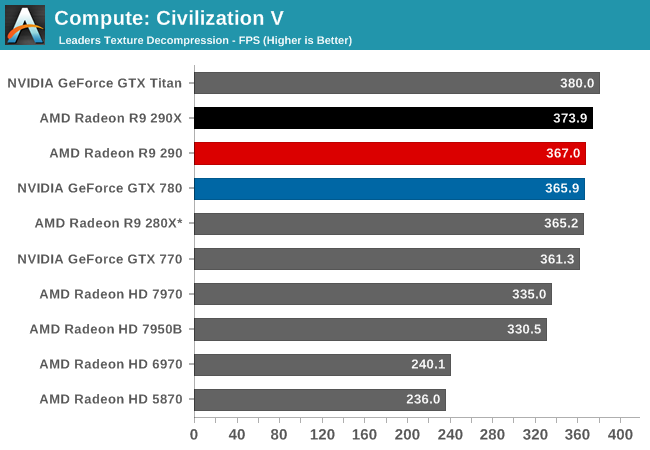
As with the 290X, Civ V can’t tell us much of value due to the fact that we’re running into CPU bottlenecks, not to mention increasingly absurd frame rates. The 290 is marginally slower than the 290X due to the lower clockspeeds and missing CUs, but minimally so.
Our next benchmark is LuxMark2.0, the official benchmark of SmallLuxGPU 2.0. SmallLuxGPU is an OpenCL accelerated ray tracer that is part of the larger LuxRender suite. Ray tracing has become a stronghold for GPUs in recent years as ray tracing maps well to GPU pipelines, allowing artists to render scenes much more quickly than with CPUs alone.
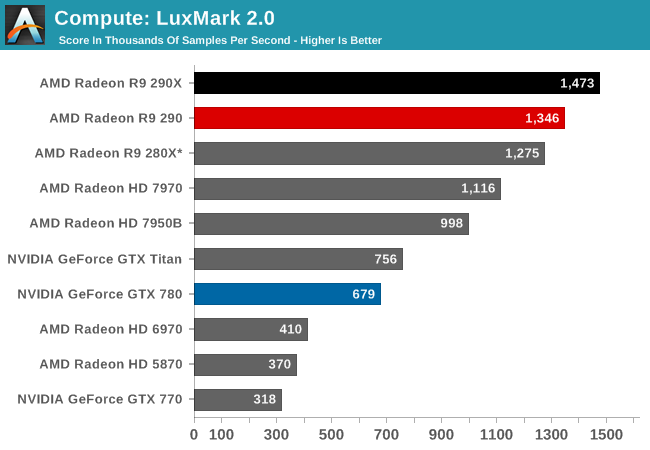
With both cards unthrottled and bound solely by shader performance, it’s an outright foot race for the Radeon cards. 290 trails 290X by around 9%, closely mirroring the difference in the CU count between the two cards. Though 290 is being very closely chased by the 280X, as Hawaii in general seems to have trouble getting the most out of its shader hardware on this benchmark.
Our 3rd compute benchmark is Sony Vegas Pro 12, an OpenGL and OpenCL video editing and authoring package. Vegas can use GPUs in a few different ways, the primary uses being to accelerate the video effects and compositing process itself, and in the video encoding step. With video encoding being increasingly offloaded to dedicated DSPs these days we’re focusing on the editing and compositing process, rendering to a low CPU overhead format (XDCAM EX). This specific test comes from Sony, and measures how long it takes to render a video.
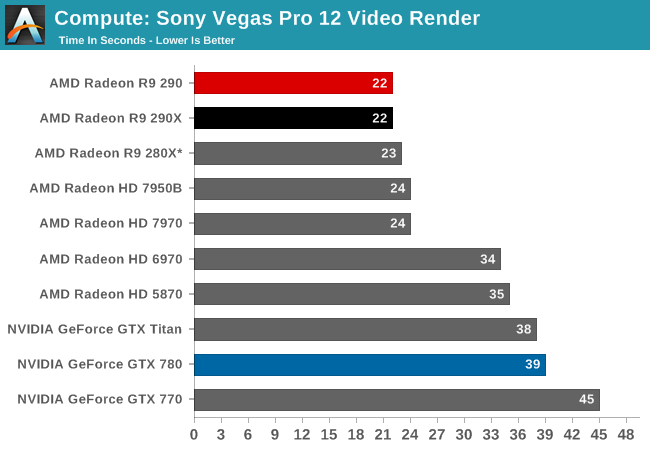
There’s not enough of a GPU performance difference between the two cards to matter with this test. Both tie at 22 seconds.
Our 4th benchmark set comes from CLBenchmark 1.1. CLBenchmark contains a number of subtests; we’re focusing on the most practical of them, the computer vision test and the fluid simulation test. The former being a useful proxy for computer imaging tasks where systems are required to parse images and identify features (e.g. humans), while fluid simulations are common in professional graphics work and games alike.
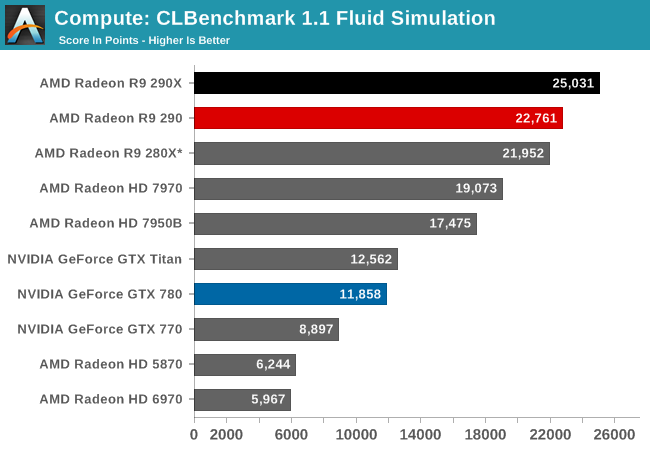

In the CLBenchmark fluid simulation the 290X and 290 take the top spots as expected, with the 290 trailing once more by 9%. However both Hawaii cards are still struggling with the computer vision benchmark, leading to the 290 being edged out by the 7970 of all things.
Moving on, our 5th compute benchmark is FAHBench, the official Folding @ Home benchmark. Folding @ Home is the popular Stanford-backed research and distributed computing initiative that has work distributed to millions of volunteer computers over the internet, each of which is responsible for a tiny slice of a protein folding simulation. FAHBench can test both single precision and double precision floating point performance, with single precision being the most useful metric for most consumer cards due to their low double precision performance. Each precision has two modes, explicit and implicit, the difference being whether water atoms are included in the simulation, which adds quite a bit of work and overhead. This is another OpenCL test, as Folding @ Home has moved exclusively to OpenCL this year with FAHCore 17.
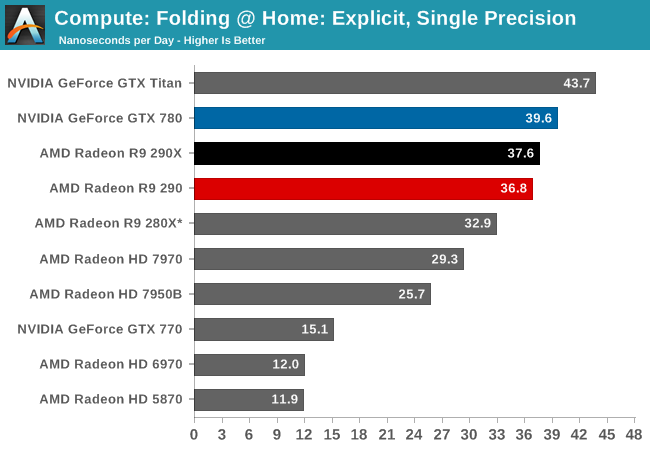
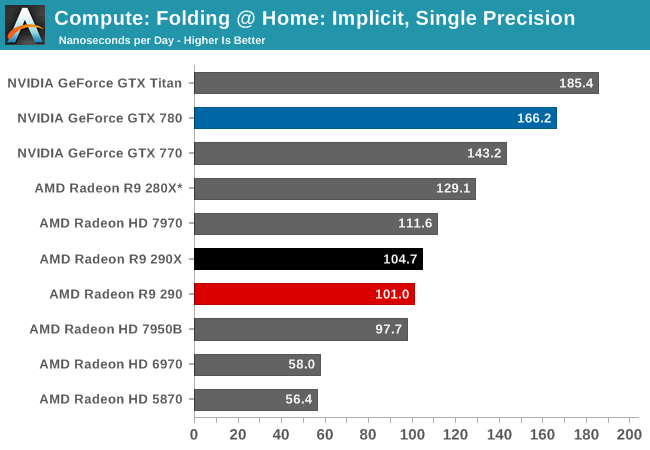
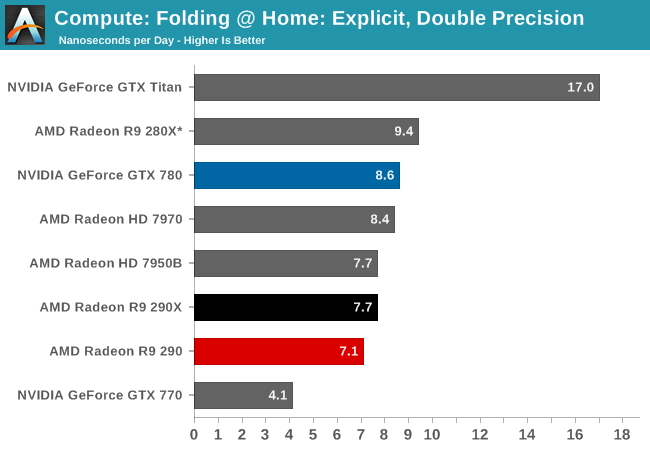
Generally Tahiti and Hawaii are strong performers in the GPU compute arena, but that isn’t of particular help to the 290 here, as it loses out to the GTX 780 in every mode. In single precision FAHBench has trouble putting Hawaii to good use at times, while double precision tests have the 1/8th DP rate 290 and 290X falling behind due to their lower than Tahiti DP throughput.
Wrapping things up, our final compute benchmark is an in-house project developed by our very own Dr. Ian Cutress. SystemCompute is our first C++ AMP benchmark, utilizing Microsoft’s simple C++ extensions to allow the easy use of GPU computing in C++ programs. SystemCompute in turn is a collection of benchmarks for several different fundamental compute algorithms, as described in this previous article, with the final score represented in points. DirectCompute is the compute backend for C++ AMP on Windows, so this forms our other DirectCompute test.
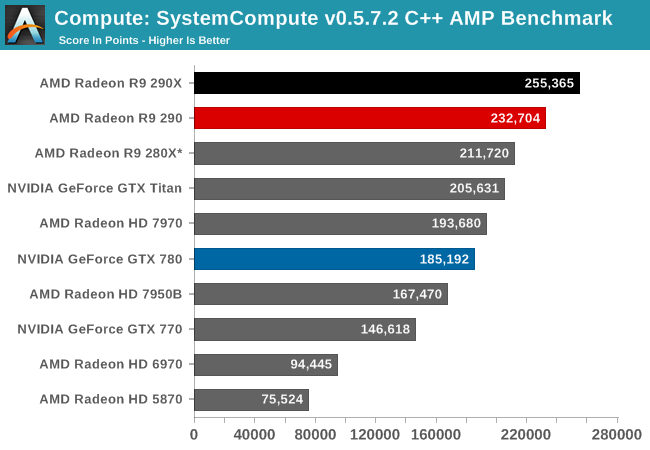
SystemCompute is another benchmark where 290 and 290X do not experience meaningful throttling, and as such are separated by more than what happens in our gaming benchmarks. In this case 290 yet again trails 290X by 9%, though it still enjoys a considerable lead over the GTX 780 and all other NVIDIA cards.










295 Comments
View All Comments
HisDivineOrder - Tuesday, November 5, 2013 - link
Haha, spoken like someone who's never heard a card this loud. I can't wait to see all these cards on sale on ebay and forums everywhere. "I tried it and it's not for me, sidegrading to a 780," they'll say.This card is so loud you're going to be shocked by it. It's going to blow people's minds and it may even convert a few fanboys.
Finally - Tuesday, November 5, 2013 - link
If he buys one with a nice custom fan, there won't be anything left to complain about. Truly terrible outlook for an Nvidiot, isn't it?TheJian - Tuesday, November 5, 2013 - link
You're forgetting they are using ref NV also. You don't get that when you buy an NV card and they come overclocked on top of quiet. Also this thing will draw the same watts no matter what. It remains to be seen how good a different cooler will actually be. Did AMD really choose two terrible fans for their product launch? Seriously? I'm wondering how much they can really fix this situation. AMD had to know this would cause bad reviews about noise nearly everywhere and even on AMD loving sites. I can't believe they are completely dumb, and chose a total piece of junk for the fan/heatsink here. I really think people are putting to much faith in a fix with a fan change. They are at 95 all day basically, how much fan do you need to fix that?If NV runs their gpus at 95 tomorrow (and cranked up even more to meet the noise they're getting here) these cards will both be spanked. You get a better cooler on NV cards that are NOT ref also.
jnad32 - Tuesday, November 5, 2013 - link
The way I look at it, AMD is looking like an absolute genius. Everyone was ripping them on the 290X for it being too hot and too loud anyway. So instead of keeping the sound levels down they just went for what they do best, price/performance. They are now blowing every other card out of the water. There isn't a card on the planet that can touch this card in price/performance. Yea its loud as hell but, at least you have to think about it now just because of the price. What I really want to see is them unleash the 290X sound threshold and see what kind of raw numbers it can put up. Lets be honest, the only people who should buy reference cards are the ones who are putting water blocks on them.People have been saying this about the temp since launch, and I still don't get it. If AMD designed the chip to run at those temps, what's the big deal as long as it's not damaging it.
swing848 - Tuesday, November 5, 2013 - link
It will only get loud for me when playing games or the occasional benchmark. During games I wear headphones, and during benchmarks I can leave the room. I have a room dedicated to computer use and the house has good sound proofing, so, it will not bother other people.If I want it quiet I will use a water cooler with a large radiator and fan.
It is better than dumping all the hot air from the video card into my case, even if it is well cooled with 200mm fans. I overclock my CPU and I do not want it, RAM, or chips on the motherboard to get any hotter than necessary.
zeock9 - Tuesday, November 5, 2013 - link
The burning question on my mind at this point is why AMD is restricting board partners from releasing their own custom designed and obviously better performing coolers on this otherwise fantastic card?techkitsune - Tuesday, November 5, 2013 - link
They likely don't want to look bad.It's okay. It's tough doing thermal management. I cram 1,000w of LED into a 30mm x 30mm space. AMD doesn't have the cooling problems that I have. Nor does nVidia nor intel. They should be grateful. :D
HisDivineOrder - Tuesday, November 5, 2013 - link
They don't have them yet. That's why they haven't made custom boards. They're just getting them right now. They're going with what they have, which right now are just the reference boards. In a month or so, they'll have QA'ed some solutions with pre-existing cooling options, assuming said cooling options are good enough to benefit these cards.The thing is, you have to know these cards are running REALLY, REALLY hot to hit these levels at 95 degrees, so... custom coolers may have a hard time handling these cards without some tweaks. Perhaps to get faster fans on there.
Also, it takes time to redesign a board to add VRM's and the 290 and 290X are still very, very new. You're not going to get an MSI Lightning version overnight.
It's a solid deal in price, but man it's a shame AMD didn't offer a better custom cooler more attuned to the very special needs of the 290 series. It's also a shame their board is being pushed so hard and so much above what it seems capable of doing with reasonable power levels.
This is like the Bulldozer of GPU's.
techkitsune - Tuesday, November 5, 2013 - link
AMD could have just spent a few more dollars and used copper instead of aluminum, I would think. They could have easily doubled or tripled thermal conductivity and thus not needed to run the reference cooler anywhere near as high, plus that would leave a LOT of extra overclocking room.I still would buy it for the extra $45 that would have likely entailed, though I do worry about weight at that point. My 9800 GTX+ was pretty hefty, to say the least.
TheinsanegamerN - Tuesday, November 5, 2013 - link
THIS. why does amd, or heck, any manufacturer, insist on using aluminum fins on a 250 watt+ gpu? my old amd 2600xt had a full copper heatsink, and it was nowhere near as power hungry as this card (and it ran cool to boot. never over 47c).use the exact same heatsink, but make those fins copper. wonder how much lower the temps would go?